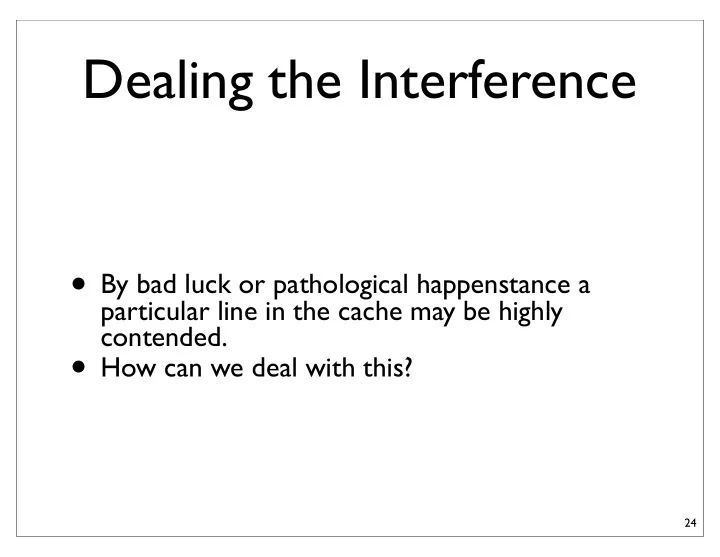

Dealing the Interference • By bad luck or pathological happenstance a particular line in the cache may be highly contended. • How can we deal with this? 24
Interfering Code. int foo[129]; // 4*129 = 516 bytes int bar[129]; // Assume the compiler 0x000 foo aligns these at 512 byte boundaries ... while(1) { 0x400 bar for (i = 0;i < 129; i++) { s += foo[i]*bar[i]; } } • Assume a 1KB (0x400 byte) cache. • Foo and Bar map into exactly the same part of the cache • Is the miss rate for this code going to be high or low? • What would we like the miss rate to be? • Foo and Bar should both (almost) fit in the cache! 25
Associativity • (set) Associativity means providing more than one place for a cache line to live. • The level of associativity is the number of possible locations • 2-way set associative • 4-way set associative • One group of lines corresponds to each index • it is called a “set” • Each line in a set is called a “way” 26
Associativity dirty valid Tag Data Way 0 Set 0 Way 1 Set 1 Set 2 Set 3 27
New Cache Geometry Calculations • Addresses break down into: tag, index, and offset. • How they break down depends on the “cache geometry” • Cache lines = L • Cache line size = B • Address length = A (32 bits in our case) • Associativity = W • Index bits = log2(L/W) • Offset bits = log2(B) • Tag bits = A - (index bits + offset bits) 28
Practice • 32KB, 2048 Lines, 4-way associative. • Line size: 16B • Sets: 512 • Index bits: 9 • Tag bits: 19 • Offset bits: 4 29
Fully Associative and Direct Mapped Caches • At one extreme, a cache can have one, large set. • The cache is then fully associative • At the other, it can have one cache line per set • Then it is direct mapped 30
Eviction in Associative caches • We must choose which line in a set to evict if we have associativity • How we make the choice is called the cache eviction policy • Random -- always a choice worth considering. Hard to implement true randomness. • Least recently used (LRU) -- evict the line that was last used the longest time ago. • Prefer clean -- try to evict clean lines to avoid the write back. • Farthest future use -- evict the line whose next access is farthest in the future. This is provably optimal. It is also impossible to implement. 31
The Cost of Associativity • Increased associativity requires multiple tag checks • N-Way associativity requires N parallel comparators • This is expensive in hardware and potentially slow. • The fastest way is to use a “content addressable memory” They embed comparators in the memory array. -- try instantiating one in Xlinix. • This limits associativity L1 caches to 2-8. • Larger, slower caches can be more associative. • Example: Nehalem • 8-way L1 • 16-way L2 and L3. • Core 2’s L2 was 24-way 32
Increasing Bandwidth • A single, standard cache can service only one operation at time. • We would like to have more bandwidth, especially in modern multi-issue processors • There are two choices • Extra ports • Banking 33
Extra Ports • Pros: Uniformly supports multiple accesses • Any N addresses can be accessed in parallel. • Costly in terms of area. • Remember: SRAM size increases quadratically with the number of ports 34
Banking • Multiple, independent caches, each assigned one part of the address space (use some bits of the address) • Pros: Efficient in terms of area. Four banks of size N/4 are only a bit bigger than one cache of size N. • Cons: Only one access per bank. If you are unlucky, multiple accesses will target the same bank (structural hazard). 35
Recommend
More recommend